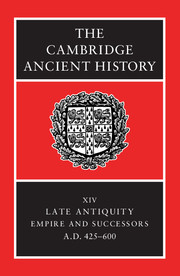Book contents
- Frontmatter
- PART I CHRONOLOGICAL OVERVIEW
- PART II GOVERNMENT AND INSTITUTIONS
- PART III EAST AND WEST: ECONOMY AND SOCIETY
- 12 Land, labour and settlement
- 13 Specialized production and exchange
- 14 The family in the late Roman world
- 15 Family and friendship in the west
- 16 State, lordship and community in the west (c. A.D. 400–600)
- 17 Armies and society in the later Roman world
- PART IV THE PROVINCES AND THE NON-ROMAN WORLD
- PART V RELIGION AND CULTURE
- Conclusion
- Chronological Table
- BIBLIOGRAPHY
- Index
- References
15 - Family and friendship in the west
from PART III - EAST AND WEST: ECONOMY AND SOCIETY
Published online by Cambridge University Press: 28 March 2008
- Frontmatter
- PART I CHRONOLOGICAL OVERVIEW
- PART II GOVERNMENT AND INSTITUTIONS
- PART III EAST AND WEST: ECONOMY AND SOCIETY
- 12 Land, labour and settlement
- 13 Specialized production and exchange
- 14 The family in the late Roman world
- 15 Family and friendship in the west
- 16 State, lordship and community in the west (c. A.D. 400–600)
- 17 Armies and society in the later Roman world
- PART IV THE PROVINCES AND THE NON-ROMAN WORLD
- PART V RELIGION AND CULTURE
- Conclusion
- Chronological Table
- BIBLIOGRAPHY
- Index
- References
Summary
At the beginning of the fifth century the senatorial aristocracy of the late empire seemed well assured of its future. Its great dynasties, the Anicii and Symmachi among them, appear full of confidence in the letter collections of the period – those of Symmachus himself, but also of Jerome, Augustine and Paulinus of Nola. Nor were they much shaken by the initial break-up of the western empire, despite panic-stricken reactions to the arrival of the barbarians and to the invasions of the Huns. At the end of the fifth century the Italian aristocracy appears as confident as ever in the inscriptions of the Colosseum and in the letters of Ennodius of Pavia. Its Gallic counterpart, a little less grand in status, but of nearly comparable wealth, dominates the letter collections of Sidonius Apollinaris, Ruricius of Limoges and Avitus of Vienne, as well as having a significant profile in that of Ennodius (Provençal by birth, albeit Italian in his career). By the mid sixth century, however, the greatest of these dynasties were no longer a power in the west: Justinian’s Ostrogothic wars had destroyed their Italian base, although the Anicii themselves were still of some importance in Constantinople. However, while the front rank of the aristocracy had collapsed in Italy, in the successor states of Gaul its provincial counterpart survived, as is again evidenced by a letter collection, this time the poetic epistles of Venantius Fortunatus. In all probability it had also managed to hang on to much of its wealth.
- Type
- Chapter
- Information
- The Cambridge Ancient History , pp. 416 - 436Publisher: Cambridge University PressPrint publication year: 2001

